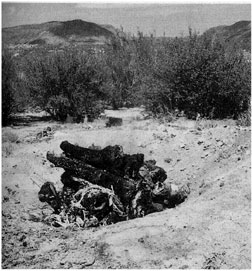
IX. Preliminary Heating
The vessels were arranged 1 foot apart in a circle and at the margin of a brush pile on the surface of the ground. Once ignited, the brush burned away after fifteen minutes. If it was windy, soot might get on some vessels but the final firing would clean them. Rogers said that the potter explained this roasting as a test but the real function was to rid the vessels of all moisture before sudden exposure to the extreme heat of the kiln. Josefina Ochurte of Santa Catarina bypassed this stage. She allowed some drying time as she coiled the pots and the hot dry air of the Santa Catarina region likely made preliminary heating unnecessary.
X. Final Firing
To fire eight pieces of pottery, Rosa Lopez dug a pit 14 inches deep by 2 feet across and lined the bottom with small stones about 4 inches in diameter, spaced so that twigs could be placed between them to start the fire. Five pottery pieces were arranged upside down on the stones. Large slabs of dry bark from dead oak were set on edge between the pots and leaned against them on the outside, completely encircling them. A second tier of pots was stacked upside down over the first and even larger bark slabs were laid about and over the top of the entire pile. Unlike Pueblo firing, the fuel was in contact with the vessels.
The kiln had been dug on the lee side of a hill protected from the wind. A vertical draft was essential to distribute the heat evenly and prevent smudging. To avoid steam, dryness of the site was also important.
In the evening when the wind had subsided and the last bark slab arranged, the potter lit the twigs in the bottom of the kiln and walked away. It was bad luck to turn and watch or even approach the kiln until the fire had died out. They believed it would cause the pots to crack.
If the draft was strong, parts of the vessels would glow a dull red. Where the vessel was touched by fuel, a dark carbon patch would form that would burn away if enough fire remained. Highly carbonized cooking pots were often cleaned by placing them in the kiln with new vessels.
Rogers noted that the conditions of the kiln were not the same for all pots. For the first forty-five minutes, as the fuel was turning to coals, the temperature was fairly uniform. But for the next two hours the considerable heat of the coals mainly affected the lower tier. On the following morning the pots were removed from the kiln and the ashes whisked from the vessels with a meal brush.
After the firing but while the vessels were still hot, the Yuma would flick a weak solution of mesquite gum in water over the entire outer surface of painted ware and on decorated water ollas to set the paint and waterproof them. The gum was found as globules on the trunks and branches of the old trees and dissolved in water by boiling.
Ken Hedges, in his studies of the Northern Diegueño at Santa Ysabel, specified that the coast live-oak bark was considered best for firing pottery, although they fueled the kiln with the bark of other oaks as well. In the desert foothill region of the eastern Southern Diegueño, dead leaves of the Mohave yucca (Yucca schidigera) replaced oak bark as the principal fuel. At Santa Catarina the dry trunks of the Mohave yucca commonly fueled the kiln. They were spaced to allow an even burn around the pots. Michelsen found that Petra Higuera's yucca fire lasted about one hour and saw that her ollas became a mottled cherry red at the fire's height.
Rogers wrote that cattle dung was occasionally used by the Southern Diegueño, and it still is at Santa Catarina. The Yuma fired their pots with cottonwood, willow driftwood, mesquite branches or any other woody scrubs. The Kamia branch of the Southern Diegueño, living in the Colorado Desert, fired pots with the dead roots of the salt bush (Atriplex lentiformis). Rogers felt that this plant's low resinous content helped prevent smudging and fire stains on Kamia pottery.

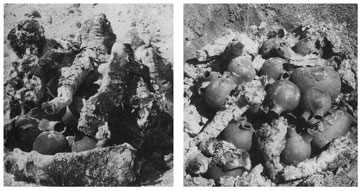
Without preliminary firing but having only been dried in the hot sun, the clay pots were stacked in an open fashion, one on top of another, in the center of a shallow pit oven in the sandy soil. They were covered evenly with large pieces of dry trunks of Mohave yucca and some bark tinder. The fuel was set ablaze and allowed to burn to ashes, about one hour. Only toward the end did Castro rearrange some of the glowing embers to one side or the other to close up gaps in the fire.
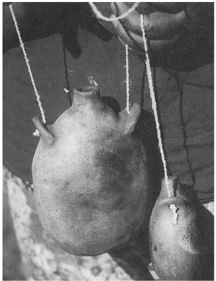
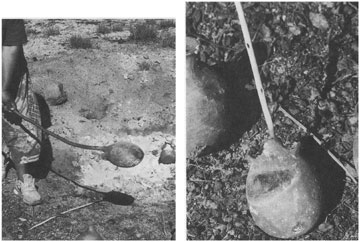
With a long stick Castro carefully removed the hot, fired
pots and clay canteens from the oven and placed them on the ground
to quicken the cooling process. Half an hour later, the canteens
were ready and strung with agave fiber string. Sections of the
spongy white center of fresh Spanish bayonet (Yucca whipplei)
flower stalk made perfect corks.
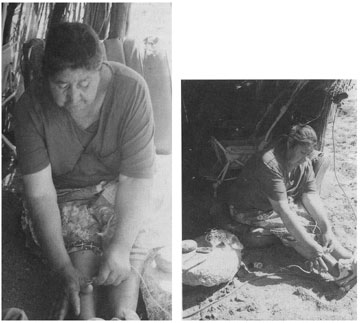
Teresa Castro had only short leftover scraps of agave fiber with which to make cords for her newly fired canteens. She had to splice in additional lengths with almost every roll of the palm but it did not seem to slow her down a whit. Like some cleverly designed machine, she rolled out long lengths of finished cordage .from raw fiber in minutes. Where she held the finished cord separated.from the two strands of yet untwisted fiber, she overlapped additional agave fiber about 1 inch onto the shorter, 1-inch strand; and pinching the splice between thumb and forefinger rolled the palm of the other hand away from her against her leg, twisting separately and at once both the spliced and unspliced strands. Releasing the grip, the two strands sprang naturally together for 2 or 3 inches. Often, when splicing like this, she did not reverse the rolling motion of the hand to tighten the two-ply twist but first twisted considerably more of the two strands on a second outward roll if the palm, firming up the splice. At the end of the outward roll, the back of the palm brought the nearer strand up and over the other, slightly winding them together, before reversing and twisting them firmly together in the opposite direction where tension on each strand naturally assisted. And so she continued making strong two-ply agave cordage.
The article is from the book, entitled "Survival Skills of Native California" (ISBN 0-87905-921-4), by Paul Douglas Campbell. Permission to use the article on the PrimitiveWays website was given by Mr. Campbell. Paul Campbell can be contacted through his publisher, Gibbs Smith, P.O. Box 667, Layton, Utah 84041.
We hope the information on the PrimitiveWays website is both instructional and enjoyable. Understand that no warranty or guarantee is included. We expect adults to act responsibly and children to be supervised by a responsible adult. If you use the information on this site to create your own projects or if you try techniques described on PrimitiveWays, behave in accordance with applicable laws, and think about the sustainability of natural resources. Using tools or techniques described on PrimitiveWays can be dangerous with exposure to heavy, sharp or pointed objects, fire, stone tools and hazards present in outdoor settings. Without proper care and caution, or if done incorrectly, there is a risk of property damage, personal injury or even death. So, be advised: Anyone using any information provided on the PrimitiveWays website assumes responsibility for using proper care and caution to protect property, the life, health and safety of himself or herself and all others. He or she expressly assumes all risk of harm or damage to all persons or property proximately caused by the use of this information.
© PrimitiveWays 2013